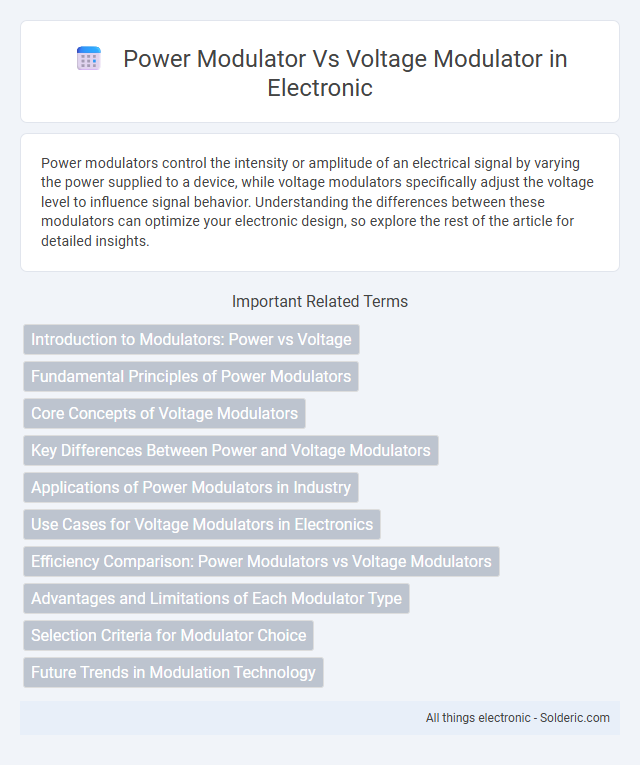Power modulators control the intensity or amplitude of an electrical signal by varying the power supplied to a device, while voltage modulators specifically adjust the voltage level to influence signal behavior. Understanding the differences between these modulators can optimize your electronic design, so explore the rest of the article for detailed insights.
Comparison Table
| Feature | Power Modulator | Voltage Modulator |
|---|---|---|
| Primary Function | Controls and adjusts power output | Controls and adjusts voltage levels |
| Application | Used in RF amplifiers, radar systems, and high-power devices | Used in voltage regulation, signal processing, and communication circuits |
| Output Parameter Controlled | Power (Watts) | Voltage (Volts) |
| Signal Type | High-power pulses or continuous waveforms | Voltage waveforms, often analog or digital signals |
| Key Components | Transistors, transformers, pulse modulators | Operational amplifiers, varistors, voltage regulators |
| Example Usage | Pulsed power systems, power supply modulation | Voltage stabilizers, amplitude modulation in communication |
Introduction to Modulators: Power vs Voltage
Power modulators regulate the amplitude or duration of electrical pulses to control energy delivery in high-voltage applications, whereas voltage modulators adjust the voltage level of a signal without altering its energy or power significantly. Your choice between power and voltage modulators depends on whether the primary need is to manage pulse power in systems such as particle accelerators or to maintain signal integrity in communication circuits. Understanding the operational differences is crucial for optimizing efficiency and performance in electronic and electrical systems.
Fundamental Principles of Power Modulators
Power modulators operate by controlling the amplitude, duration, and frequency of electrical pulses to regulate power delivery in high-energy applications, utilizing techniques such as pulse-width modulation and switching circuits. Voltage modulators adjust the voltage level of an AC or DC signal through methods like buck, boost, or buck-boost converters, focusing on maintaining stable voltage output under varying load conditions. Your understanding of power modulators involves managing energy flow precisely for applications like radar or particle accelerators, while voltage modulators emphasize voltage stabilization in power supplies and electronic devices.
Core Concepts of Voltage Modulators
Voltage modulators control output voltage by varying input voltage or regulating the conduction angle of semiconductor devices, ensuring precise voltage levels. Core concepts include pulse-width modulation (PWM), linear regulation, and buck-boost techniques, which adjust voltage with minimal distortion and high efficiency. Understanding these principles allows you to select or design voltage modulators tailored for consistent power delivery in applications requiring stable voltage control.
Key Differences Between Power and Voltage Modulators
Power modulators regulate the power output to control the energy delivered to a load, whereas voltage modulators specifically adjust the voltage level to maintain a stable output. Power modulators are essential in applications requiring precise control of power signals, such as radar and pulsed lasers, while voltage modulators are commonly used in voltage regulation for electronic circuits and communication systems. The key difference lies in their control focus--power modulators emphasize energy flow management, and voltage modulators concentrate on voltage stability and consistency.
Applications of Power Modulators in Industry
Power modulators are extensively used in industrial applications such as radar systems, pulsed laser equipment, and particle accelerators, where precise control of high-power pulses is essential. These devices enable efficient energy transfer and switching in systems requiring rapid bursts of electrical energy, critical for processes like plasma generation and materials processing. Unlike voltage modulators, which primarily alter signal amplitude for communication and audio equipment, power modulators handle substantial power levels to drive heavy industrial loads and high-energy machinery.
Use Cases for Voltage Modulators in Electronics
Voltage modulators are widely used in electronics for regulating and stabilizing power supplies in devices such as radios, televisions, and communication equipment. Your circuits benefit from voltage modulators when maintaining signal integrity and preventing fluctuations that could cause malfunction or noise interference. Unlike power modulators that control output amplitude, voltage modulators specifically manage voltage levels to ensure consistent performance in sensitive electronic applications.
Efficiency Comparison: Power Modulators vs Voltage Modulators
Power modulators generally offer higher efficiency by directly controlling the power delivered to the load, minimizing energy losses during modulation. Voltage modulators, while providing precise voltage control, often exhibit lower efficiency due to continuous power dissipation in regulating elements like resistors or linear components. In high-performance applications, power modulators are preferred for their ability to maximize energy conversion efficiency and reduce thermal management requirements.
Advantages and Limitations of Each Modulator Type
Power modulators offer high efficiency and the ability to handle large power levels, making them ideal for applications requiring precise energy control, but they often come with increased size and complexity. Voltage modulators provide better control over voltage amplitude with simpler circuitry and faster response times, yet they typically struggle with power handling capacity and may introduce distortion under heavy loads. Your choice depends on whether efficiency and power capability or voltage precision and simplicity best meet your system requirements.
Selection Criteria for Modulator Choice
Selection criteria for choosing between a power modulator and a voltage modulator include the specific application requirements, such as the desired output power level and voltage stability. Power modulators are ideal when managing high energy pulses and controlling large current flows, while voltage modulators are preferred for precise voltage regulation and minimizing signal distortion. Your decision should also consider factors like efficiency, modulation speed, and the compatibility with existing system components to ensure optimal performance.
Future Trends in Modulation Technology
Power modulators are evolving toward higher efficiency and precision in controlling high-voltage and high-current pulses for advanced applications like particle accelerators and radar systems. Voltage modulators increasingly integrate semiconductor technologies and digital control for enhanced modulation speed and stability in communication and signal processing devices. Emerging trends emphasize adaptive modulation schemes, energy-efficient designs, and integration with AI algorithms to optimize performance across power and voltage modulation systems.
Power modulator vs voltage modulator Infographic

 solderic.com
solderic.com